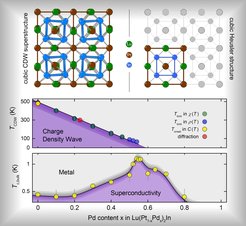Charge density wave quantum critical point with strong enhancement of superconductivity
Superconductivity, the ability to transport electric current without losses, is not only a fascinating phenomenon, but also one of practical relevance for reducing energy consumption in a future world. While the “standard” type of superconductivity, the so-called BCS type, has been discovered more than 100 years ago and explained 60 years ago, a new type of superconductivity, known as unconventional superconductivity, has become the focus of intense research in the past decades. This unconventional type of superconductivity is usually observed when a material which shows magnetic order is tuned by chemical substitution or the application of pressure in such a way that the magnetic order disappears continuously. The central question here is whether or not and how the unconventional superconducting state is induced by the fluctuations of the disappearing magnetic order.
In most cases the temperature Tc, at which such systems becomes superconducting, is a smooth function of the tuning parameter, with a broad maximum near the critical point where the magnetic order disappears. Therefore, the relevance of the critical fluctuations of the disappearing magnetic order is not obvious. An international team of scientist from the Max Planck Institute for Chemical Physics of Solids in Dresden, Germany, in collaboration with scientist from the Institut Laue-Langevin in Grenoble, France, discovered a new system where Tc presents a sharp maximum just at the critical point, providing a more direct evidence for the relevance of quantum critical fluctuations. In contrast to other systems, the critical point is not connected with the disappearance of magnetic order, but with the disappearance of a structural and charge order. Critical points associated with structural and charge order have been much less studied than those associated with magnetic order.
When studying the new compound LuPt2In, the main author Dr Thomas Gruner and his supervisor Dr Christoph Geibel first noticed clear evidences for a combined structural and charge order, a so-called Charge Density Wave (CDW), at a temperature TCDW = 490 K. By partially substituting the isovalent Pd for Pt, they could continuously tune the transition temperature TCDW from 490 K in the pure system to TCDW = 0 at 58 % Pd substitution. Upon studying the properties of this system in more details and to lower temperatures, the team discovered the superconductivity with a sharp maximum in Tc just at the critical concentration of 58 % Pd. Since LuPt2In is a convenient system where large single crystals can be grown and thus many experiments shall be accessible, it shall be possible to perform an in-depth study of this unusual behaviour, which is expected to shed deep insight into the connection between critical fluctuations and onset of superconductivity.

In short
Superconductivity: A superconductor is a material in where the electrical resistivity drops abruptly to zero when its temperature decreases below a critical value, the superconducting transition temperature Tc. Thus, superconductors can transport electric currents without any losses when cooled below Tc, in contrast to standard electrical cables made of copper, in where the small - but finite electrical resistivity - results in energy loss.
Charge Density Wave: In some metallic systems the spatial distribution of electrons (the elementary particles with a negative electrical charge) becomes unstable below a critical temperature, the CDW transition temperature TCDW. Below TCDW, the electrons reorganize themselves in a spatially modulated arrangement, which looks like a snapshot of a perfect wave on the surface of a fluid. This modulation induces an analogue modulation of the positively charge core of the atoms, and thus to a (very small) change in the structure of the material.
Quantum Critical Point: A critical point is a set of parameter, e.g. temperature, pressure, or magnetic field, at which a system changes its state of matter, e.g. from ice to water. When this transition occurs at finite temperatures, its properties are defined by thermal fluctuations and it is then called a classical critical point. If the transition occurs at T = 0 K, the absolute zero, thermal fluctuations died out and the properties near the critical point are determined by quantum fluctuations, hence the name Quantum Critical Point.

TG, CG / CPfS

